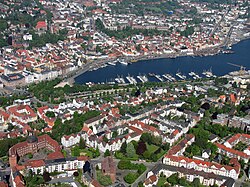List



The following table lists the 35 cities and communes in Schleswig-Holstein with a population of at least 15,000 on December 31, 2017, as estimated by the Federal Statistical Office of Germany. [2] A city is displayed in bold if it is a state or federal capital.
- The city rank by population as of December 31, 2017, as estimated by the Federal Statistical Office of German [2]
- The city name [2]
- The name of the district (Landkreis) in which the city lies (some cities are districts on their own called urban districts) [2]
- The city population as of December 31, 2017, as estimated by the Federal Statistical Office of Germany [2]
- The city population as of May 9, 2011, as enumerated by the 2011 European Union census [3]
- The city land area as of December 31, 2017 [2]
- The city population density as of December 31, 2017 (residents per unit of land area) [2]
| 2017 rank | City | District | 2017 estimate | 2011 census | 2017 land area | 2017 pop. density |
|---|---|---|---|---|---|---|
| 1 | Kiel | urban district | 247,943 | 235,782 | 119 km² | 2,090/km² |
| 2 | Lübeck | urban district | 216,318 | 210,305 | 214 km² | 1,010/km² |
| 3 | Flensburg | urban district | 88,519 | 82,258 | 56.7 km² | 1,560/km² |
| 4 | Neumünster | urban district | 79,335 | 77,249 | 71.6 km² | 1,108/km² |
| 5 | Norderstedt | Segeberg | 78,679 | 73,913 | 58.1 km² | 1,354/km² |
| 6 | Elmshorn | Pinneberg | 49,618 | 47,459 | 21.4 km² | 2,322/km² |
| 7 | Pinneberg | Pinneberg | 43,155 | 41,137 | 21.5 km² | 2,003/km² |
| 8 | Wedel | Pinneberg | 33,347 | 31,248 | 33.8 km² | 986.0/km² |
| 9 | Ahrensburg | Stormarn | 33,305 | 31,380 | 35.3 km² | 943.5/km² |
| 10 | Itzehoe | Steinburg | 31,848 | 30,885 | 28.0 km² | 1,136/km² |
| 11 | Geesthacht | Herzogtum Lauenburg | 30,407 | 28,755 | 33.3 km² | 914.5/km² |
| 12 | Rendsburg | Rendsburg-Eckernförde | 28,789 | 27,594 | 23.7 km² | 1,213/km² |
| 13 | Henstedt-Ulzburg | Segeberg | 28,056 | 26,658 | 39.5 km² | 710.8/km² |
| 14 | Reinbek | Stormarn | 27,409 | 26,169 | 31.2 km² | 877.6/km² |
| 15 | Schleswig | Schleswig-Flensburg | 25,118 | 23,701 | 24.3 km² | 1,034/km² |
| 16 | Bad Oldesloe | Stormarn | 24,964 | 24,263 | 52.6 km² | 474.6/km² |
| 17 | Husum | Nordfriesland | 23,274 | 22,215 | 25.8 km² | 901.7/km² |
| 18 | Eckernförde | Rendsburg-Eckernförde | 21,979 | 21,943 | 21.4 km² | 1,028/km² |
| 19 | Heide | Dithmarschen | 21,699 | 20,768 | 32.0 km² | 678.7/km² |
| 20 | Kaltenkirchen | Segeberg | 21,386 | 19,709 | 23.1 km² | 925.8/km² |
| 21 | Quickborn | Pinneberg | 21,056 | 19,727 | 43.2 km² | 487.7/km² |
| 22 | Bad Schwartau | Ostholstein | 19,997 | 19,436 | 18.4 km² | 1,087/km² |
| 23 | Schenefeld | Pinneberg | 19,141 | 18,197 | 10.0 km² | 1,916/km² |
| 24 | Mölln | Herzogtum Lauenburg | 18,928 | 18,398 | 25.1 km² | 755.6/km² |
| 25 | Uetersen | Pinneberg | 18,429 | 17,456 | 11.4 km² | 1,612/km² |
| 26 | Glinde | Stormarn | 18,365 | 16,640 | 11.2 km² | 1,637/km² |
| 27 | Halstenbek | Pinneberg | 17,700 | 16,376 | 12.6 km² | 1,407/km² |
| 28 | Bad Segeberg | Segeberg | 17,273 | 16,592 | 18.9 km² | 915.4/km² |
| 29 | Stockelsdorf | Ostholstein | 17,071 | 16,517 | 56.7 km² | 301.1/km² |
| 30 | Eutin | Ostholstein | 16,946 | 16,449 | 41.4 km² | 409.3/km² |
| 31 | Schwarzenbek | Herzogtum Lauenburg | 16,374 | 14,974 | 11.6 km² | 1,416/km² |
| 32 | Bargteheide | Stormarn | 16,045 | 15,164 | 15.8 km² | 1,014/km² |
| 33 | Preetz | Plön | 16,041 | 15,471 | 14.4 km² | 1,114/km² |
| 34 | Ratekau | Ostholstein | 15,285 | 15,217 | 59.6 km² | 256.4/km² |
| 35 | Neustadt in Holstein | Ostholstein | 15,187 | 15,024 | 19.7 km² | 769.4/km² |
